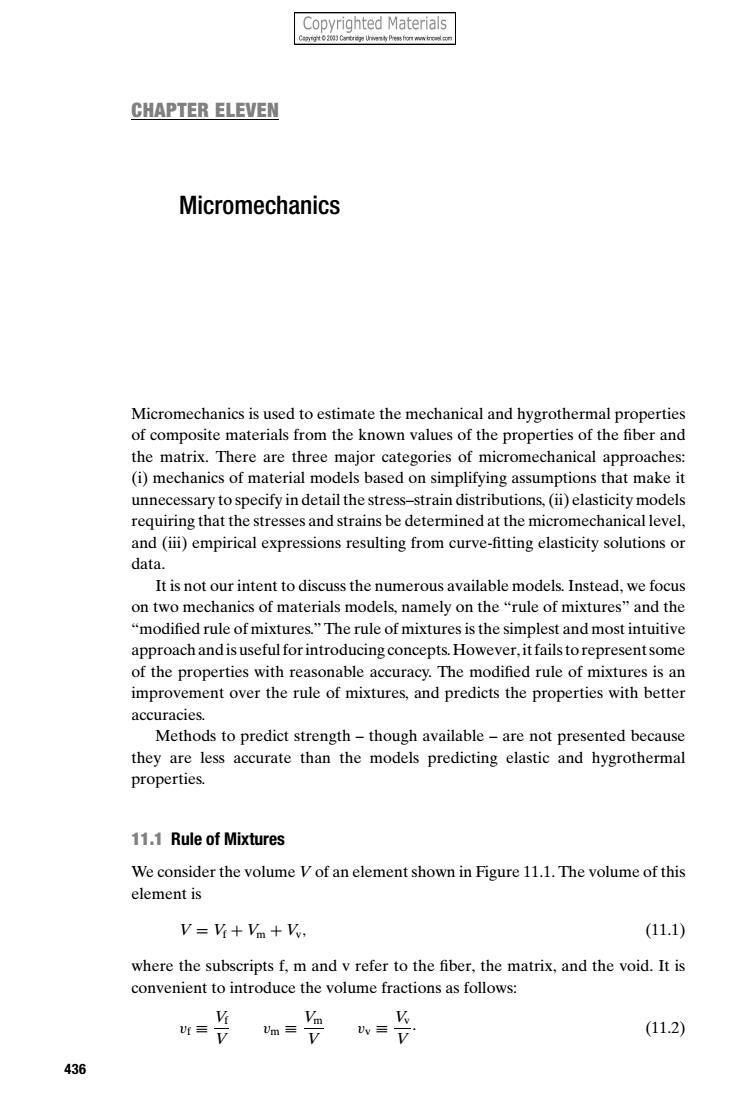正在加载图片...

Copyrighted Materials rU Press frw CHAPTER ELEVEN Micromechanics Micromechanics is used to estimate the mechanical and hygrothermal properties of composite materials from the known values of the properties of the fiber and the matrix.There are three major categories of micromechanical approaches: (i)mechanics of material models based on simplifying assumptions that make it unnecessary to specify in detail the stress-strain distributions,(ii)elasticity models requiring that the stresses and strains be determined at the micromechanical level, and(iii)empirical expressions resulting from curve-fitting elasticity solutions or data. It is not our intent to discuss the numerous available models.Instead,we focus on two mechanics of materials models,namely on the "rule of mixtures"and the "modified rule of mixtures."The rule of mixtures is the simplest and most intuitive approach and is useful for introducing concepts.However,it fails to represent some of the properties with reasonable accuracy.The modified rule of mixtures is an improvement over the rule of mixtures,and predicts the properties with better accuracies. Methods to predict strength-though available-are not presented because they are less accurate than the models predicting elastic and hygrothermal properties. 11.1 Rule of Mixtures We consider the volume V of an element shown in Figure 11.1.The volume of this element is V=V+Vn+V, (11.1) where the subscripts f,m and v refer to the fiber,the matrix,and the void.It is convenient to introduce the volume fractions as follows: Vm (11.2) 436CHAPTER ELEVEN Micromechanics Micromechanics is used to estimate the mechanical and hygrothermal properties of composite materials from the known values of the properties of the fiber and the matrix. There are three major categories of micromechanical approaches: (i) mechanics of material models based on simplifying assumptions that make it unnecessary to specify in detail the stress–strain distributions, (ii) elasticity models requiring that the stresses and strains be determined at the micromechanical level, and (iii) empirical expressions resulting from curve-fitting elasticity solutions or data. It is not our intent to discuss the numerous available models. Instead, we focus on two mechanics of materials models, namely on the “rule of mixtures” and the “modified rule of mixtures.” The rule of mixtures is the simplest and most intuitive approach and is useful for introducing concepts. However, it fails to represent some of the properties with reasonable accuracy. The modified rule of mixtures is an improvement over the rule of mixtures, and predicts the properties with better accuracies. Methods to predict strength – though available – are not presented because they are less accurate than the models predicting elastic and hygrothermal properties. 11.1 Rule of Mixtures We consider the volume V of an element shown in Figure 11.1. The volume of this element is V = Vf + Vm + Vv, (11.1) where the subscripts f, m and v refer to the fiber, the matrix, and the void. It is convenient to introduce the volume fractions as follows: vf ≡ Vf V vm ≡ Vm V vv ≡ Vv V . (11.2) 436